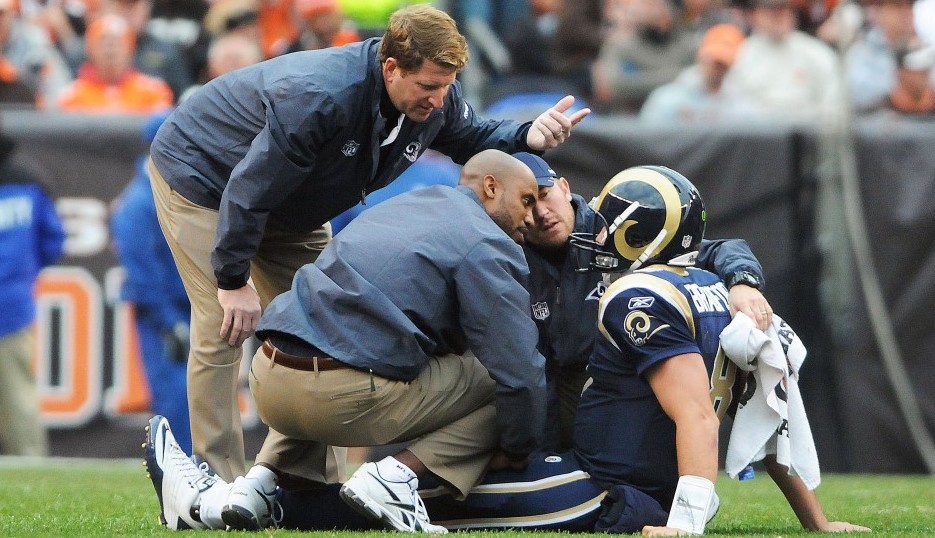Bradford’s ACL: What Are the Odds?
Much of the angst surrounding the Sam Bradford acquisition is tied to that twice surgically-repaired left knee of his.
The 27-year-old first ruptured the ACL in October, 2013 against the Panthers when he planted awkwardly while being pushed out of bounds late in the game. He suffered the same injury 10 months later in a preseason contest against the Browns as his hyperextended leg momentarily bore the weight of a falling pass rusher. Two tears in the span of a year does not exactly inspire confidence that the knee will hold up moving forward. And it seems logical to conclude that a player who has multiple ACL injuries on his resume would be more susceptible to a third.
But that’s not necessarily the case.
To get a better understanding for the situation, we spoke with Dr. James L. Carey, Director of the Penn Center for Advanced Cartilage Repair and Assistant Professor of Orthopaedic Surgery at the Perelman School of Medicine at the University of Pennsylvania. From Dr. Carey’s vantage point, does the fact that Bradford is coming off two ACL ruptures make it more likely that he will sustain a third?
“No,” he replied. “In my opinion, I don’t think that he’s at an increased risk for a third injury any more so than his other knee or the knees of any other NFL quarterback.”
The odds of re-injuring the same knee are relatively low. According to Carey, studies have shown that the probability of re-tearing a reconstructed ACL is about three to six percent. (Those studies were on the general population, not just football players. But they line up with other findings that suggest the chance of a recurrent injury to the same knee amongst NFL players within two years is about five to six percent.) Meanwhile, the probability of tearing the other knee — or the “native ACL” — is higher, around nine to 12 percent.
“You would think the reconstructed ACL would be more at risk. And it’s really changed our behavior a lot in how we treat these athletes when they return to play,” said Carey. “For example, bracing used to be pretty common after ACL reconstruction. At this point, I guess the question is: which knee do you want to brace? The other knee is actually at a higher risk in general.”
The reason for the lower odds? Part of it, Carey theorizes, is that the tissue used to reconstruct may be a little bit bigger than the native ACL. If the original ACL is seven millimeters, say, it might have been replaced with a nine millimeter graft, so there’s more give. Also, because of all of the attention that leg receives during rehab, it’s not uncommon for patients to feel that the reconstructed side is the stronger of the two.
Bradford turned out to be part of that three-to-six percent group that ruptured the same ACL twice. What to make of it? Carey likened an ACL tear to pulling out a kitchen drawer just hard enough that it jumps off the rails and hits the ground. Oftentimes, you fix the stop, put the drawer back in its grooves and the issue never comes up again. But in some cases, the same elements come together and the drawer pops back out.
“I think it’s just kind of one of those freak deals,” said Bradford at his introductory press conference. “From everyone I’ve talked to – our team doctors in St. Louis, Dr. [James] Andrews, they just thought that it was one of those things where they felt like I got hit a certain way two times and regardless of whether my ACL was an original, a repair, it was going to tear. So I think it just happened.”
“We’ve done our due diligence in terms of talking to Dr. Andrews in terms of what we are getting,” said Chip Kelly. “So we feel very confident in where Sam is.”
While the chances of a re-tear are pretty low, Carey said that athletes that have had multiple ACL ruptures in the same knee are at greater risk for cartilage damage and arthritis. So there could be some long-term effects down the road.
Bradford’s injury history goes beyond ACLs, of course. He missed a chunk of games in 2011 with a high ankle sprain. Was sidelined most of his junior season at Oklahoma with an injury to his throwing shoulder that eventually required surgery.
At some point, don’t you have to say that a player is injury-prone?
“I think it’s mostly the environment that the athletes are in,” Carey opined. “In football, there are a lot of ankle sprains and ACL ruptures. It’s part of the nature of the game. I think all of the athletes are vulnerable to these injuries — it’s part of the game — but I don’t think that any one athlete is systematically more prone to these injuries than any other athlete, really.”
Though there can be contributing factors, from style of play to training. Kelly puts a big focus on the latter, as we know, utilizing sports science and personalized regimens to try and maximize output and reduce the chance of injury.
To that end, Carey cited the American Academy of Orthopaedic Surgeons‘ findings that “neuromuscular training programs could reduce ACL injuries.”
“Basically for every 109 patients that they treated, they prevented one ACL,” said Carey, who added that such programs have the best chance of preventing non-contact injuries. “So I think there is a benefit. Between the preseason and training camp, the Eagles probably touch about 109 players, and they can save an ACL. And in a game like the NFL, which is a game of inches and seconds, boy, one player can be a huge thing.”
Especially if that player turns out to be your starting quarterback.
